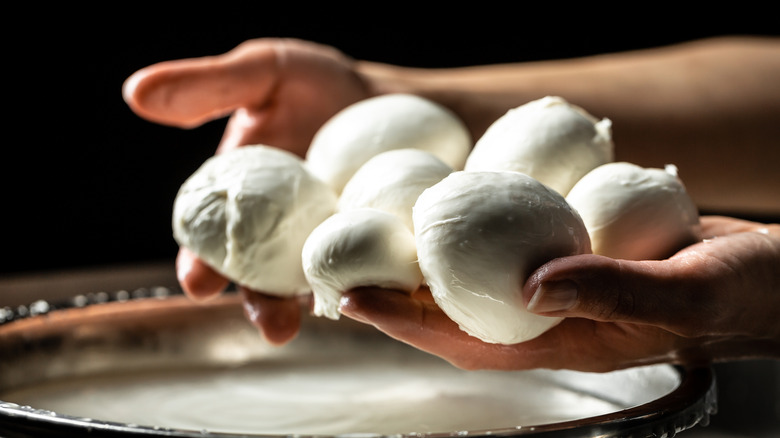Does Refrigerating Fresh Mozzarella Actually Ruin It?
Refrigeration is always the best way to store food, correct? Well, that may be up for debate. You might want to forget the fridge when it comes to dairy products like freshly-made mozzarella, per An American in Rome.
With southern Italian roots, Ristorazione Italiana Magazine explains that mozzarella comes from the word mozzare (meaning to cut), which describes how to make mozzarella fresh where the curd is torn by hand to create the semi-soft cheese. Pearly and smooth, mozzarella can be best described as mild and milky, even if there are a few different varieties with unique traits. For example, Eataly shares that fior di latte is a sweet cow's milk mozzarella, whereas mozzarella di bufala is a tangy rendition made from buffalo milk, and burrata is a rich, stretched mozzarella filled with stracciatella (made with shreds of mozzarella curds and cream). Then there's also mozzarella that ranges in shape from the hand-knotted nodini to bite-sized bocconcini.
Although all mozzarella tends to be fairly stringy and spongy, Cheese.com shares that fresh mozzarella (the kind kept in water or whey) is significantly more creamy and moist than mass-produced versions of the cheese — it's also more fickle when it comes to storage.
Keep fresh mozzarella at room temperature for better taste and texture
Although it may sound like an old wive's tale, most Italians swear by keeping fresh mozzarella at room temperature unless it is highly processed or if you plan on cooking with it. But is there any truth to this storage method? We're here to help solve the great refrigeration debate once and for all.
According to La Cucina Italiana, it's wise to keep mozzarella at room temperature so that it can maintain its tender and milky consistency and even enhance its characteristically acidic taste. Food scientist Dave Arnold (via Taste) explains that when fresh mozzarella is stored in the fridge, it risks becoming rubbery as the cold causes the curd to absorb more water, leading the texture to tighten and become unpleasantly firm.
For the best mozzarella eating experience, temperature and timing are essential. Since artisanal mozzarella is made without preservatives, La Cucina Italiana recommends eating it as soon as possible — ideally the same day of purchase — and keeping the cheese submerged in its brine slightly below room temperature between 64 F and 68 F until you decide to make a fresh tomato and mozzarella salad.

